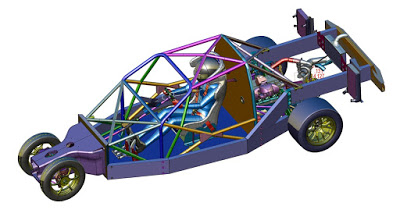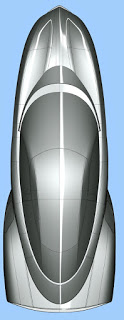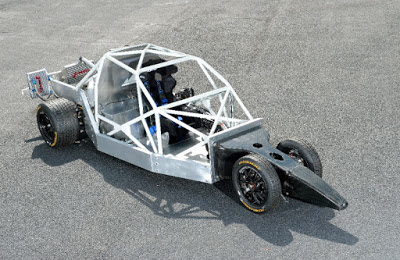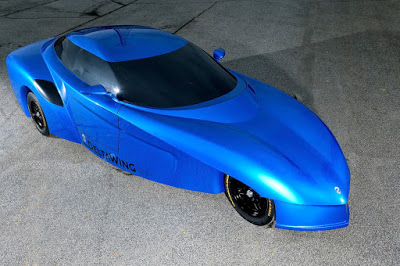Concept car showcases new design for a highly-efficient, street-legal two-seat GT.
DeltaWing Technology Group today revealed at Road Atlanta a full-size concept of what a Panoz DeltaWing GT street-legal car could look like, as well as a DeltaWing® GT race car concept chassis. Reveal provided a glimpse of the fuel and energy efficient DeltaWing® architecture in another form. The display showcases the company’s rapid progress toward a new DeltaWing racecar and ultimately a highly efficient Panoz DeltaWing® GT.
Both are on display October 1-3 in the DeltaWing Racing Cars and Panoz exhibit in Road Atlanta’s Vendor Village. Road Atlanta is home to the 18th Annual Petit Le Mans powered by Mazda, the finale of the 2015 TUDOR United SportsCar Championship and the Tequila Patrón North American Endurance Cup season.
The Panoz DeltaWing GT concept car and DeltaWing GT racecar concept chassis broke cover just six months after DeltaWing Technology Group’s March 2015 announcement that it would begin developing a DeltaWing GT racecar concept. Development began immediately after the company received the results of an independent engineering analysis of a four-
passenger road car concept based on the patented DeltaWing narrow front
track vehicle architecture.
That analysis showed it could achieve nearly 74 mpg highway and 57 mpg combined. The team then focused on further refinement of the architecture and design, preparing for prototype development. As a result, the Panoz DeltaWing GT road car design’s coefficient of drag in simulation has been optimized and currently is in the 0.26 Cd range.
DeltaWing’s vehicle architecture can be defined as a “green technology multi-tool.” The architecture can accept virtually any current or future transverse engine powertrain and deliver significant fuel savings and green benefits when compared to traditional vehicle designs. The DeltaWing platform also can be fitted with all-electric or hybrid powertrains; today’s smaller and lighter high-efficiency gas, diesel and compressed natural gas (CNG) engines.
As a result, it can reduce EV range anxiety and help put more EVs on the road, further reducing emissions and helping improve air quality. Other benefits include further extending a diesel-powered vehicle’s already impressive range as well as reducing emissions from gasoline-powered vehicles by up to 42 percent and even extend the range of hydrogen fuel cell vehicles.
Sports car endurance racing fans are familiar with the DeltaWing. It debuted as the inaugural Garage 56 entry at the 2012 24 Hours of Le Mans and quickly proved it could compete with technology rather than brute horsepower. Today the Claro/Tracfone DeltaWing Racing Cars DWC-13 Coupe competes in IMSA’s 2015 TUDOR United SportsCar Championship with about half the weight and aerodynamic drag, half the horsepower, and half the fuel consumption while delivering the same performance as its competitors.
The DeltaWing Technology Group engineering and design team leverages the data acquired through racing and applies it to next-generation projects like the DeltaWing GT. For example, many DeltaWing GT racecar concept sub-assemblies like steering and suspension are derived from the DWC-13 Coupe, and what has been learned about the DWC-13’s driving dynamics influence the direction of the DeltaWing GT street and race projects. Preliminary DeltaWing GT racecar concept targets call for a vehicle powered by a 350 to 400 horsepower engine and weighing about 1,800 to 2,000 pounds, depending on the powertrain.
The goal is to begin real-world testing of a DeltaWing GT race car concept prototype in 2015 to further drive the company’s goal of creating both a two-passenger Panoz DeltaWing GT and four-passenger Panoz DeltaWing car for the road. Like the DeltaWing DWC-13 Coupe, the company hopes to acquire valuable data through motorsports but has not announced official plans to race the DeltaWing GT racecar concept.
For more information about DeltaWing projects, please visit http://deltawingtech.com/





